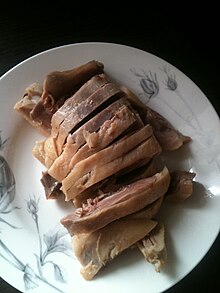This article needs additional citations for verification. (September 2011) |
 | |
| Alternative names | Chinese: 盐水鸭, 鹽水鴨 |
|---|---|
| Type | Duck dishes |
| Place of origin | China |
| Region or state | Nanjing |
| Associated cuisine | Jinling cuisine, Jiangsu cuisine |
| Similar dishes | Peking duck |
Nanjing salted duck (simplified Chinese: 盐水鸭; traditional Chinese: 鹽水鴨; pinyin: yánshuǐ yā) is a local duck dish from Nanjing, China.[1][2] The history of the dish goes back hundreds of years, possibly to the 14th century, but it grew more famous during the Qing Dynasty.[3] The tender white duck-meat has some fat but is not greasy, and in presentation the dish is fragrant and often crispy. Although available all year round, experts believe that duck in autumn inherently possesses a sweet scent of osmanthus and is therefore best in this season.[4] In line with this statement, some cooked-meat product shops have started experimenting with the use of osmanthus to flavour duck.[4] Nanjing salted duck prepared shortly before or after mid-Autumn is reputed to taste the best, because of duck production during the sweet osmanthus[5] blooming season (osmanthus may be added to the spice mixture particularly in those months). Sometimes the seasonal version of the dish is called "osmanthus duck".[6]
Nanjing is a culinary centre noted for its Jinling dishes,[7] especially quality ducks and a whole variety of duck dishes.[8] Over 100 million ducks per year are eaten in the city of 8 million.[9]
Nanjing salted duck reigns supreme on the table in southern China, just as Peking duck reigns supreme in northern China.[4] For the people of Nanjing, eating salted duck once a day seems to have become a regular habit.[10] Some historians believe that the ducks were first raised as livestock by the Nanjing people more than two thousand years ago.[6] The Nanjing salted duck is recorded as a gourmet entry in the List of Jinling’s Delicacies by the modern Chinese gourmet Tongzhi Zhang.[11] Most of Nanjing's most famous duck shops are located around the Shuiximen area.[10] The key to the formation of the unique flavour of Nanjing salted duck is the oxidation and degradation of the duck fat, which is achieved throughout the production process through a series of steps including dry-curing, salting, roasting and boiling.[12] In parts of China, taro and salted duck are a unique combination.[4] Over the years, Nanjing salted duck has achieved a number of honourable achievements in different fields.[6]
- ^ Foster, Simon (2010). Frommer's China. Wiley. p. 407. ISBN 9780470497654.
- ^ Knapp, Ronald. Chinese landscapes: the village as place. p. 217.
- ^ "A duck dish to die for". www.chinadaily.com.cn. Retrieved 2022-03-17.
- ^ a b c d Cite error: The named reference
:7was invoked but never defined (see the help page). - ^ Anncoo Journal: Osmanthus Jelly 桂花糕
- ^ a b c "Nanjing Salted Duck - China - Chinadaily.com.cn". www.chinadaily.com.cn. Retrieved 2022-03-17.
- ^ "Food in Nanjing, China: Best Food and Restaurants". Museum of Wander. 2021-09-21. Retrieved 2022-03-17.
- ^ "Nanjing Salted Duck". Archived from the original on 2012-10-03. Retrieved 2012-08-18.
- ^ "Taste buds tantalized in nation's 'duck capital'".
- ^ a b Cite error: The named reference
:0was invoked but never defined (see the help page). - ^ Cite error: The named reference
:3was invoked but never defined (see the help page). - ^ Cite error: The named reference
:6was invoked but never defined (see the help page).